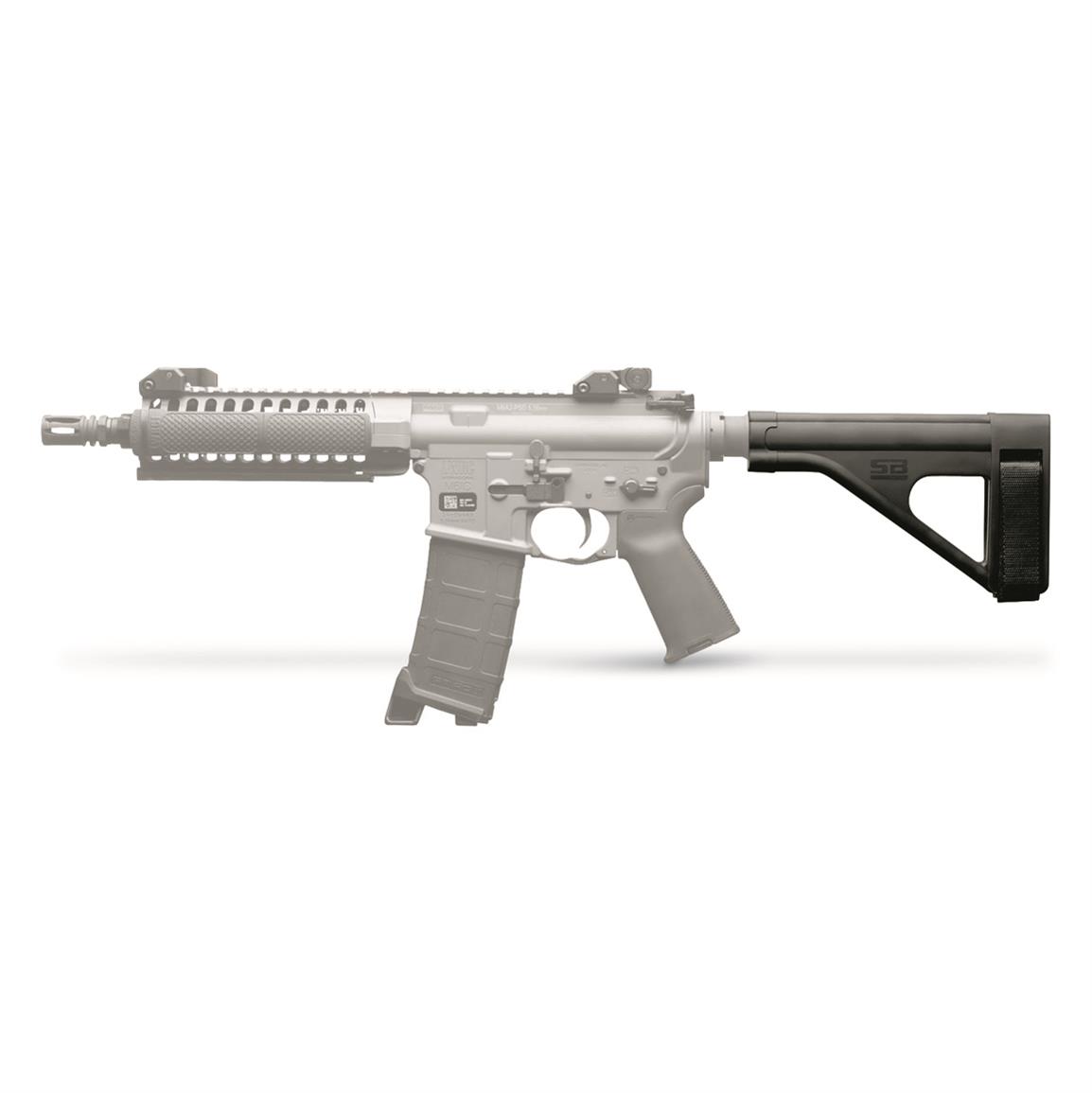ATF Pistol Brace Ruling May be a Trojan Horse for Biden Administration
America’s 700,000 owners of pistol braces received a gift from an unlikely source the day before Christmas Eve. However, the gift may be a Trojan horse.
On Dec. 23, the Bureau of Alcohol Tobacco and Firearms (ATF) announced it was withdrawing a notice and request for comments regarding stabilizing braces, titled “Objective Factors for Classifying Weapons with ‘Stabilizing Braces.'” These braces are devices that replace buttstocks and are designed and intended only for use as forearm supports to provide a more stable firearm platform. They are neither designed nor intended to be fired from the shoulder. This notice effectively affirms the subjective criteria ATF uses in determining whether a firearm is an NFA item or not; it is not a “new” directive.
While the ending of public comments and withdrawal of the guidance seems like a victory, the issue is still pending the Department of Justice review, according to the ATF statement. It opens up the possibility of more aggressive action being taken by the incoming Biden administration.
The withdrawal of the guidance came hours after U.S. Rep. Richard Hudson (R-North Carolina) and 89 other Congress members sent a letter to the ATF demanding that the bureau “immediately take action to correct this injustice.”
The “injustice,” as we previously reported, was that the proposed guidelines were confusing to owners as well as vendors and could potentially lead to felony charges.
“We would like to thank the NRA members, gun owners, and members of Congress who stood up for the Second Amendment rights of all Americans,” a press release from NRA-ILA stated. “And, special thanks to Majority Leader Mitch McConnell and Congressman Hudson for taking the lead in pushing ATF to rethink its arbitrary and unhelpful ‘guidance.'”
In 2012, the pistol brace took the shooting community by storm as it gave those wishing to avoid the otherwise-required federal paperwork, or who prefer a way to legally build carbines with barrels less than 16 inches, a cost-effective and perfectly legal option. Pistol braces became a favorite among gun owners with disabilities who find it difficult to handle and fire a rifle of conventional length.
Throughout two presidential administrations, the ATF wavered on how to classify this innovation, as well as the maximum length for concealable barrels and what exactly constitutes “illegal shouldering.” See our recap here.
Century Old Root of the Problem
Todd Rathner, the Executive Director of the NFA Freedom Alliance, told International Sportsman the entire situation demonstrates the flaws of the National Firearms Act and the power it places in unelected bureaucrats even 96 years after its initial passage.
“If there’s one thing Americans are good at, it’s figuring out what’s legal and what’s not legal, and creating products that fit into that legal niche, that is truly American ingenuity,” Rathner said, of the innovation of pistol braces.
But the nature of federal agencies is not to let the populous determine that, which has resulted in many absurd decisions by both federal rule-makers and agents in the field.
“If you miss the barrel length by an inch this way or an inch that way, you risk a federal felony — it’s absurd,” Rathner said. “There’s no question that ATF is a dysfunctional agency that has operated in the realm of patchwork. It seems like every other week they are changing their minds on definitions from bump stocks, to pistol braces, to what is a silencer, to what is not a silencer — the list goes on.”
Rathner described the NFA as “a complete disaster; a terrible statute that should be repealed in its entirety, including the Hughes amendment.”
The ATF, Rathner said, started out more as a tax collection agency but has morphed into a regulatory entity with an aggressive enforcement arm.
Without going through the proper legislative process, Rathner continued, owners are not only left in a continual lurch as to when the rug will be pulled out from under them but are also given vague guidance.
“A law-abiding gun owner who wishes to comply with the law is never given an objective set of standards, such as whether their firearm with a brace is classified a short-barrel rifle or not,” Rathner said. “If the ATF came up with specific criteria — if you have a firearm that has a barrel length of more than this or less than that, or a specific length of pull, or if it weighs over a specific amount — then a citizen could comply with that. But having a checklist of 10 factors, some of which may apply, and some may not, and leaving that to be decided on the spot, that is too unpredictable and nearly impossible for any law-abiding gun owner to comply with.”
“This episode is an example of an agency that can’t tell left from right, or black from white, they issue a statement informing us of the subjective criteria they are using and ask for comment when the plan is to just proceed” “Unfortunately, I think this will be held over for a Biden administration and it will end up being worse for law-abiding gun owners” “My guess is this is far from the end of the matter” Said Rathner
Gun Control Trojan Horse
Most everyone agrees that the ATF is in trouble from their checkered past to the new regulations over accessories like bump stocks. However, the ATF might be Joe Biden’s best chance at having an impact on gun policy without involving Congress. He articulated plans to restructure the ATF and other Justice Department agencies to “most-effectively secure our gun laws,” adding plans to secure efficient funding for the Department of Justice to “effectively enforce our existing gun laws, increase the frequency of inspections of firearms dealers, and repeal riders that get in the way of that work.”
While the ATF backing off braces, for now, might seem an apparent win, don’t celebrate too soon, this “Friday afternoon surprise” (released just before a holiday in this case) may have been a way to take the heat off the ATF as the picture becomes rosier for federal gun control efforts.
With a Joe Biden administration imminent and a Republican majority in the Senate undetermined until the Jan. 5 Georgia runoff election, the ATF could be passing the buck to the White House in hopes an executive order or legislative push could accomplish the same goal.
Speculation aside, what we know for sure is that the ATF has to date been relatively quiet about their criteria for determining what is an NFA item, possibly to comply with the Donald Trump administration’s order that changes to all federal agency rules be printed in the Federal Register and subject to public comments. In other words, it’s not as easy to impose a rule on the American people as it once was. The comments process can be fierce and could draw more attention than what the agency would prefer.
Early commenters on the proposed changes to the pistol brace guidelines called the new criteria “arbitrary” and “subjective” rather than objective, fact-based determinations. Other comments focused on the possibility that certain pistols with a stabilizing brace would fall under a vague, default category, thereby opening manufacturers, sellers, and gun owners alike to federal prosecution and expensive litigation.
The requirement for public comments will likely change under the Biden administration. We will continue to monitor any changes. But for now, the ATF is playing it safe by punting.
Score one for the vox populi — for now, at least.
Andy Hogue is a longtime veteran of legislative politics and journalism. He makes frequent appearances on television and radio shows in the Austin area, his writing has appeared in numerous national and international media outlets. He has served as speechwriter for two state officials, publicity director for several projects at The Alamo, and was constituent services director for one of the last conservative Austin City Councilmen. For fun he likes to unload 13 rounds from his Browning Hi-Power.


